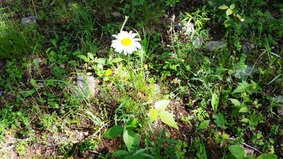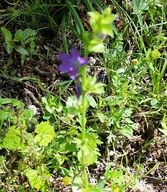 Kate's Prairie-in-Progress (June 2015)
Kate's Prairie-in-Progress (June 2015) For those of you who have been following this project, I've spent the past year trying to convert an acre of weeds and rocks on my Missouri farm to prairie flowers and grasses. So far, I've sprayed, raked, burned, and sown. To my eye, the hillside still looks pretty shabby, almost as if it's growing out a bad haircut. But when I look more closely, I notice some good things taking root.
| The plant that I've been calling Little Bunny Ears, is Coreopsis. I have hundreds of them growing on my hillside. They're going to grow up to be pretty yellow flowers. | This darker leaf has a soft, almost velvety texture. According to my prairie expert, Doug Bauer, it's going to grow up to be coneflower. I can't tell if it's Pale Purple Coneflower, Purple Coneflower, or Grayhead Coneflower. I guess I'll find out when it blooms. Cone-flowers are my favorite. | I'm pretty sure this delicate lady, who I've been calling Feathery Comb, is actually Partridge Pea. I have no idea how it got that name. (I'm going to have to ask Doug. I should also send him this report to see how smart I am about my prairie. But isn't it *fun* to learn new stuff?) |
| Oh, and woe to you who look like this. Sorry to say, but I have to pull you out by the roots. You're a noxious invasive annual weed whose broad leaves are blocking the sun from a lot of better stuff growing beneath you. So away you go. Here's the funny thing: A year ago, I was standing on this same hillside, telling my prairie godfather that I couldn't tell the good stuff from the bad. I didn't know what to keep and what to kill. One year later, I'm learning. Slowly but slowly, I'm learning. Planting a prairie is a metaphor for writing. And for life. |





